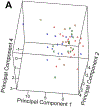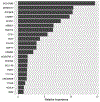Revising the Diagnosis of Idiopathic Uveitis by Peripheral Blood Transcriptomics
- PMID: 32941857
- PMCID: PMC7935743
- DOI: 10.1016/j.ajo.2020.09.012
Revising the Diagnosis of Idiopathic Uveitis by Peripheral Blood Transcriptomics
Abstract
Purpose: To test the hypothesis that idiopathic uveitis can be categorized into subtypes based on gene expression from blood.
Design: Case control study.
Methods: We applied RNA-Seq to peripheral blood from patients with uveitis associated with 1 of 4 systemic diseases, including axial spondyloarthritis (n = 17), sarcoidosis (n = 13), inflammatory bowel disease (n = 12), tubulo-interstitial nephritis with uveitis (n = 10), or idiopathic uveitis (n = 38) as well as 18 healthy control subjects evaluated predominantly at Oregon Health and Science University. A high-dimensional negative binomial regression model implemented in the edgeR R package compared each disease group with the control subjects. The 20 most distinctive genes for each diagnosis were extracted. Of 80 genes, there were 75 unique genes. A classification algorithm was developed by fitting a gradient boosting tree with 5-fold cross-validation. Messenger RNA from subjects with idiopathic uveitis were analyzed to see if any fit clinically and by gene expression pattern with one of the diagnosable entities.
Results: For uveitis associated with a diagnosable systemic disease, gene expression profiling achieved an overall accuracy of 85% (balanced average of sensitivity plus specificity, P < .001). Although most patients with idiopathic uveitis presumably have none of these 4 associated systemic diseases, gene expression profiles helped to reclassify 11 of 38 subjects.
Conclusions: Peripheral blood gene expression profiling is a potential adjunct in accurate differential diagnosis of the cause of uveitis. Validation of these results and characterization of the gene expression profile from additional discrete diagnoses could enhance the value of these observations.
Copyright © 2020 Elsevier Inc. All rights reserved.
Figures



References
Publication types
MeSH terms
Substances
Grants and funding
LinkOut - more resources
Full Text Sources
Other Literature Sources

